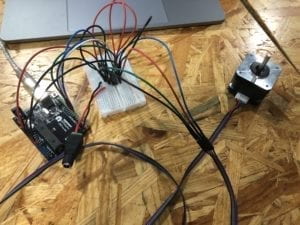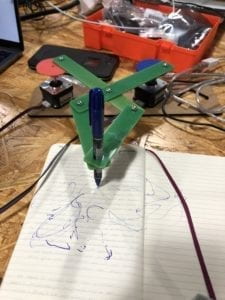Materials:
For Steps 1 and 2
1 * 42STH33-0404AC stepper motor
1 * L293D ic chip
1 * power jack
1 * 12 VDC power supply
1 * Arduino kit and its contents
For Step 3
2 * Laser-cut short arms
2 * Laser-cut long arms
1* Laser-cut motor holder
2 * 3D printed motor coupling
5 * Paper Fasteners
1 * Pen that fits the laser-cut mechanisms
Paper
Building the Circuit:
Code
const int stepsPerRevolution = 200; // change this to fit the number of steps per revolution
// for your motor
// initialize the stepper library on pins 8 through 11:
Stepper myStepper(stepsPerRevolution, 8, 9, 10, 11);
void setup() {
// set the speed at 60 rpm:
myStepper.setSpeed(60);
// initialize the serial port:
Serial.begin(9600);
}
void loop() {
// step one revolution in one direction:
Serial.println(“clockwise”);
myStepper.step(stepsPerRevolution);
delay(500);
// step one revolution in the other direction:
Serial.println(“counterclockwise”);
myStepper.step(–stepsPerRevolution);
delay(500);
}
^ In this video I am turning the motor knob, controlling the rotation with a potentiometer. I used the map function to match the movement of the knob with the rotation of the motor. At first, I thought that it wasn’t working because I was expecting it to move exactly when I turned the knob with no delay.

This was my final working circuit before starting the drawing machine.
^Video of my partner testing our final product… It worked!

We got it to draw!! It was very very hard to control both of the knobs at one time, especially because of the delay after turning it since it’s not in real-time. My partner and I had a hard time coordinating with each other to make actual designs, and could only make smooth lines when we each took a turn turning the knob all the way, and it created teardrop shapes.
Question 1:
What kind of machines would you be interested in building? Add a reflection about the use of actuators, the digital manipulation of art, and the creative process to your blog post.
After being in China for a few months, I have been thinking about it and I would love to build a machine that opens the window when the air quality is good and closes it when it’s bad. The actuator is what would allow the window to actually open once the information about the air quality was sent to it. It’s not exactly meant to be an art piece, but all of the information that the machine would need to gather would be useless without the actuator to actually carry out the activity that needs to take place. It would be something that can close the window, rather than only tell you to do so.
Question 2:
Choose an art installation mentioned in the reading ART + Science NOW, Stephen Wilson (Kinetics chapter). Post your thoughts about it and make a comparison with the work you did during this recitation. How do you think that the artist selected those specific actuators for his project?
Shawn Decker created “Scratch Series,” that have scratchers moved by microcomputer governed motors. It pulls them back and forth to make sounds of nature and animals, and after collecting the sounds it makes rhythms. The controllers that pull the scratchers back and forth are very similar to the controllers that moved the pen in the drawing machine on each side. The actuator was able to closely mimic the sounds and patterns of other things found in nature without having to be the real thing.